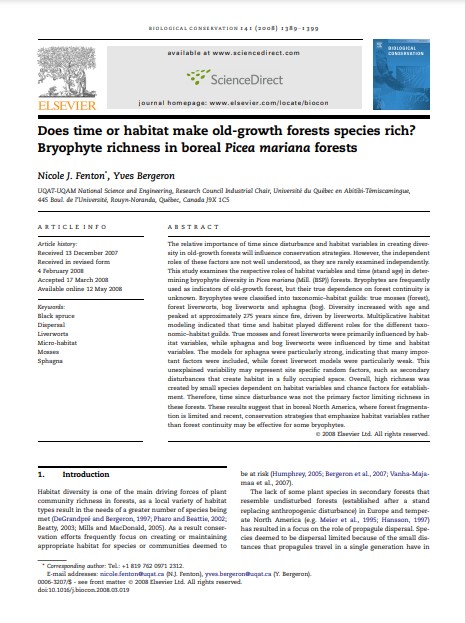Does time or habitat make old-growth forests species rich? Bryophyte richness in boreal Picea mariana forests
Bosque Modelo:
Lake Abitibi
Temática:
Gestión forestal
Tipo de documento:
Artículo científico
Resumen
The relative importance of time since disturbance and habitat variables in creating diversity in old-growth forests will influence conservation strategies. However, the independent roles of these factors are not well understood, as they are rarely examined independently. This study examines the respective roles of habitat variables and time (stand age) in determining bryophyte diversity in Picea mariana (Mill. (BSP)) forests. Bryophytes are frequently used as indicators of old-growth forest, but their true dependence on forest continuity is unknown. Bryophytes were classified into taxonomic–habitat guilds: true mosses (forest), forest liverworts, bog liverworts and sphagna (bog). Diversity increased with age and peaked at approximately 275 years since fire, driven by liverworts. Multiplicative habitat modeling indicated that time and habitat played different roles for the different taxonomic–habitat guilds. True mosses and forest liverworts were primarily influenced by habitat variables, while sphagna and bog liverworts were influenced by time and habitat variables. The models for sphagna were particularly strong, indicating that many important factors were included, while forest liverwort models were particularly weak. This unexplained variability may represent site specific random factors, such as secondary
disturbances that create habitat in a fully occupied space. Overall, high richness was created by small species dependent on habitat variables and chance factors for establishment. Therefore, time since disturbance was not the primary factor limiting richness in these forests. These results suggest that in boreal North America, where forest fragmentation is limited and recent, conservation strategies that emphasize habitat variables rather than forest continuity may be effective for some bryophytes.
Información Bibliográfica
Autor:
Fenton, NJ and Y Bergeron.
Revista:
Biological Conservation
Año:
2008
N°:
-
País :
Canadá
Páginas:
1389 - 1399
Volumen:
141
Idioma:
Ingles
Palabras claves
Black, spruce, Dispersal, Liverworts, Micro-habitat, Mosses Sphagna





